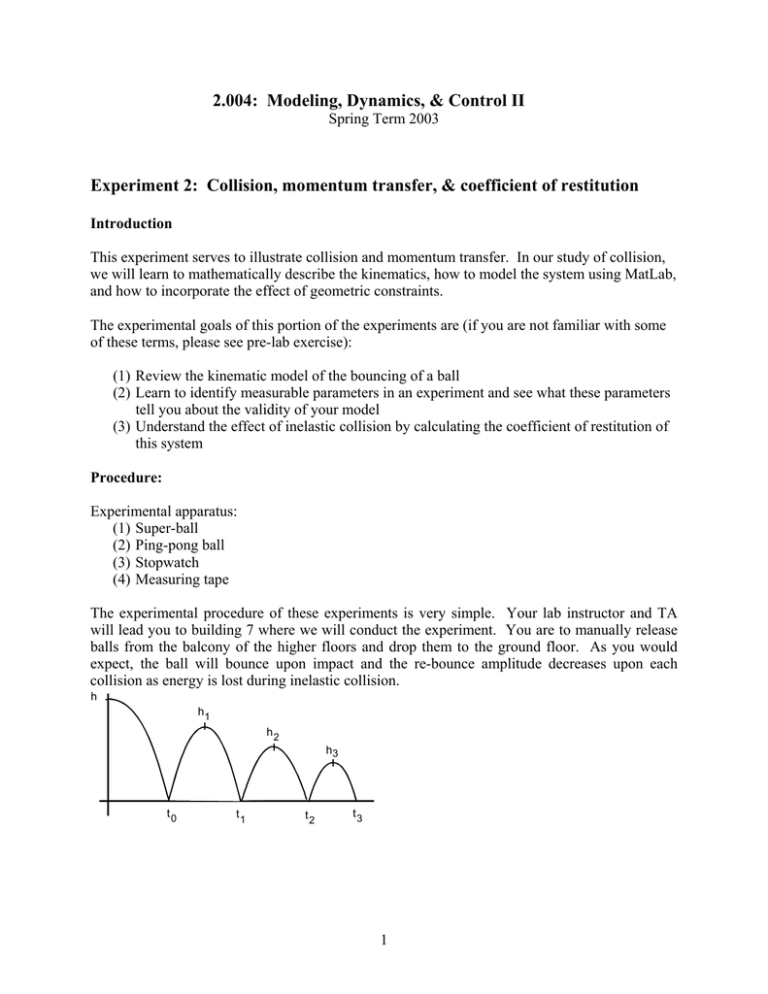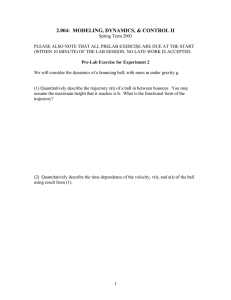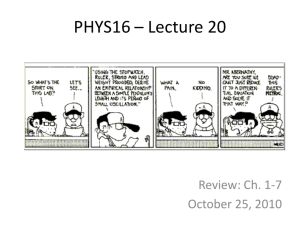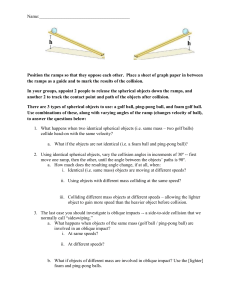2.004: Modeling, Dynamics, & Control II
advertisement

2.004: Modeling, Dynamics, & Control II Spring Term 2003 Experiment 2: Collision, momentum transfer, & coefficient of restitution Introduction This experiment serves to illustrate collision and momentum transfer. In our study of collision, we will learn to mathematically describe the kinematics, how to model the system using MatLab, and how to incorporate the effect of geometric constraints. The experimental goals of this portion of the experiments are (if you are not familiar with some of these terms, please see pre-lab exercise): (1) Review the kinematic model of the bouncing of a ball (2) Learn to identify measurable parameters in an experiment and see what these parameters tell you about the validity of your model (3) Understand the effect of inelastic collision by calculating the coefficient of restitution of this system Procedure: Experimental apparatus: (1) Super-ball (2) Ping-pong ball (3) Stopwatch (4) Measuring tape The experimental procedure of these experiments is very simple. Your lab instructor and TA will lead you to building 7 where we will conduct the experiment. You are to manually release balls from the balcony of the higher floors and drop them to the ground floor. As you would expect, the ball will bounce upon impact and the re-bounce amplitude decreases upon each collision as energy is lost during inelastic collision. h h1 h2 h3 t0 t1 t2 t3 1 The experimental parameters that you will determine are: (1) The height from which you drop the ball (2) The timing between successive bounces (you should time at least 6 bounces; how many should you measure?) (3) The weight of the balls (they will be given). You will obtain four sets of experiments. From second and third floor balconies, you will quantify the collisions of both the ping-pong and the super-ball. You are to take two trials for each ball in each case. (As is common in engineering practice, you will be restricted in the number of measurements that can be taken and the environment in which they are taken.) The stopwatch is digital and it can record multiple “stop times.” Start the watch when the ball is dropped and hit the record button during each collision. Up to 9 collisions can be recorded. Recording too many times will erase your first few times (limit of the stop watch). Report content: (1) Record your raw data for each set of experiment (2) Describe how your measurements allow you to verify the derived model (3) Plot the following parameters during each collision for each set of data as a function of impact number. (a) Time (b) Impact velocity (c) Force exerted on the ball during impact and momentum transfer (d) Coefficient of restitution (4) Please consider three additional questions related to this experiment. You may answer these questions qualitatively. As a minimum standard, you should be able to answer the first question and your grade goes up with correctly answering additional questions. (a) Look at the behavior of the ping-pong ball and the super ball after the first bounce as a function of drop height. What are the key differences between their responses? Are they behaving according to theory (see your pre-lab result)? (b) Propose a physical model to explain the observations in the ping-pong ball case. (c) Propose a physical model to explain the observations in the super ball case. PLEASE KEEP YOUR REPORTS AFTER THEY HAVE BEEN GRADED. YOU WILL NEED THIS DATA AGAIN DURING EXPERIMENT 3. 2






